PinotFile: 7.12 February 12, 2009
|
Carneros Renaissance on TrackCalifornia was still under Mexican jurisdiction in the early 1880s when Mariano Guadalupe Vallejo awarded large land grants to allow settlement of the Northern Frontier of California north of San Francisco. The Carneros region was located within the original boundaries of four of the land grants: Rincon de los Carneros, Entre Napa, Nuichica and Petaluma. The land grants were subsequently subdivided and by the 1840s there was an influx of settlers of American, German, French and Irish heritage drawn by the mild climate and the fertile lands. Sheep and cattle ranches thrived alongside fields of wine grapes, pears, plums, cherries and apples. Steve Sangiacomo of Sangiacomo Family Vineyards recalls, “My grandparents grew pears, apples and cherries when they farmed this land; my parents, uncles and aunt were among the earliest grape growers in Carneros.” The region became known as Los Carneros (Spanish for “The Ram”). Wine historian William Heintz of Sonoma has stated that Carneros may be the second oldest vineyard region in Northern California, with plantings dating to the late 1830s. One of the largest early Carneros vineyards, comprising more than 300 acres, was John Stanly’s Riverdale Ranch located south of Napa. Phylloxera had devastated all the vineyards in Carneros by the 1920s but Stanly Ranch had been planted on Vitis riparia rootstock which was resistant to phylloxera and some vines survived. Andre Tschelistcheff and Louis M. Martini both bought grapes including Pinot Noir from the Stanly Ranch in the 1930s. Charles L. Sullivan, writing in A Companion to California Wine, noted that Tschelistcheff had first appreciated the potential of Carneros for producing Burgundian-style wines after he tasted a 1918 Stanly Ranch Pinot Noir. Martini eventually owned 200 acres of the Stanly Ranch and along with Harold Olmo, did extensive Pinot Noir and Chardonnay clonal experimentation in Carneros, leading to the development of Chardonnay clone 108 and UCD clones 13 and 15 of Pinot Noir. These clones were widely planted in California from the 1970s to the early 1990s. Carneros received appellation status in 1983 and is the only AVA in California that overlaps two others in different counties (Napa and Sonoma). It was the first AVA based on climate rather than political boundaries. In 1983, there were few wineries in Carneros: Acacia, Bouchaine, Buena Vista, Carneros Creek, and Saintsbury. Saintsbury became the most popular Pinot Noir choice on restaurant lists throughout the country, but Carneros struggled for recognition against its more well-known neighbors, Napa and Sonoma. Many Napa and Sonoma wineries invested in vast acres of vineyard land in Carneros including Beaulieu Vineyards, Clos du Val, Clos Pegase, Robert Mondavi, St. Clement and William Hill. By the 1990s, the region became little more than a silent supplier for these well-known wineries which were located in the more high-profile Napa and Sonoma appellations. Pinot Noirs from the Russian River Valley, Sonoma Coast, Santa Lucia Highlands and Santa Barbara County overshadowed those from Carneros in quality. In recent years, mergers and consolidations have created very large corporate ownership in Carneros. These corporate owners and many smaller boutique operations have today led a renaissance in Carneros, dedicating themselves to producing ultra-premium wines. The emphasis has been away from mass production of grapes to more focused viticulture and the production of distinctive wines from estate grown fruit. The words, “Estate Grown” now adorn many Carneros Pinot Noir labels. The “old” Carneros Pinot Noir style has evolved with changes in how the grapes are grown and new winemakers’ philosophies. The result is that Carneros Pinot Noirs can now compete with the best from the more visible and touted appellations of California. Established labels such as Etude Winery, Beaulieu Vineyard, Buena Vista (acquired by private investors from Constellation Brands in 2008) and Cuvaison have undergone revitalization, while other long time favorites such as Acacia, Ancien, Artesa, Bouchaine Vineyards, Castle Vineyards and Winery, Domaine Carneros, Gloria Ferrer, MacRostie Winery and Vineyards, Robert Stemmler, Saintsbury, Schug Carneros Estate and Truchard Vineyards are releasing exceptional Pinot Noirs. Many new faces have fueled the renaissance as well, including Adastra, Ardiri Estate, Ceja Vineyards, Madonna Estate, Mahoney Vineyards, Mayro-Murdick Wines, Molnar Family Kazmar & Blaise, Renteria, Robledo Family Winery, Talisman Wines and The Donum Estate. A number of prominent wineries located outside the region are sourcing grapes from Carneros including Abiouness, Ambullneo, B. Kosuge Wines, Carneros Della Notte, Enkidu Wines, La Crema, Lost Canyon, Lutea, Patz & Hall, Paul Hobbs, Robert Sinskey, Steele, Whitehall Lane Winery and ZD Wines. Carneros straddles the southernmost reaches of both Napa and Sonoma. The boundary between Napa and Sonoma is marked by a white line on Ramal Road. The large (37,000 acres, over 9,000 acres planted) appellation extends from the Sonoma Mountains in
 the West to the Napa River in the East and from the Mayacamas Mountains in the North to the Southern Pacific Railroad line in the South. The most distinguishing climatic feature of the appellation is its strong maritime climatic influence. Carneros is an unshielded land open to the nearby Pacific Ocean and adjacent San Pablo Bay (the northernmost reaches of the San Francisco Bay). The resulting moderate climate features sufficient sunshine, low rainfall and plenty of fog and cooling breezes. I have never been in Carneros when the wind wasn’t blowing at least to some degree. Water needs are often met by short frequent
 irrigation during the growing season, especially in August and September. The soils are dense, shallow (averaging 3 feet), with high clay content and low to moderate fertility. The soils and climate cause the vines to struggle and yields are low. The climate creates a long growing season, a scenario that suits Chardonnay and Pinot Noir just fine. The eastern and northern parts of Carneros are significantly warmer and here warm weather varietals such as Merlot and Syrah prosper. Sustainable and green agriculture practices are widespread in Carneros. Many of the vineyards are either certified organic or certified by the California Land Stewardship Institute as adhering to sustainable practices to create a balanced farm environment relative to land and water use and preservation of the region’s ecological habitat. The Carneros Land Stewardship Foundation was established to promote the education, conservation, preservation and restoration of the land, wetlands creek beds and ecological habit in the Carneros region. Some of the most prominent Carneros growers include Durell Vineyards, Hudson Vineyards, Hyde Vineyards, Lee Vineyards, Molnar Family/Poseidon’s Vineyard, Sangiacomo Vineyards, Stanly Ranch Vineyards, Toyon Farm and Wildcat Mountain Vineyard. Carneros has the unenviable reputation of being the area one drives through to get to Napa or Sonoma. At first glance, the landscape is somewhat barren, with only a few towering eucalyptus trees planted to stem the winds from the Bay. Most wineries are not visible from the main highways that traverse the region (Highways 12, 121 and 29). However, if one takes the time to explore the back roads, the beautiful vistas of this area can truly be remarkable. Most of the sheep and cattle have disappeared long ago, but the majestic vineyards planted on undulating hillsides are a welcome sight to wine lovers (Pinot Noir vines in December at Artesa below).
 Gradually, Carneros is undergoing gentrification. The Carneros Inn, a Plumpjack Resort, was opened in 2003, located on 27 acres surrounded by vineyards and farmland. There are 86 individual cottages that are country modern in design. A spa and three restaurants on the property are first-rate. This is a perfect spot to launch your exploration of the region (www.thecarnerosinn.com). Multiple other accommodations and restaurants are only minutes away in the towns of Napa and Sonoma. Most of the wineries of Carneros have tasting rooms and their hours and locations are available on The Carneros Wine Alliance website at www.carneros.com. (The former Carneros Quality Alliance, formed in 1983, was renamed The Carneros Wine Alliance in 2005 and Phyllis Gillis was hired as Executive Director to direct more attention to Carneros) Some wineries require appointments for tours and tasting. An excellent Carneros Appellation Brochure including a useful map is available from the Alliance ( a small copy is shown below).
 The Carneros region’s major annual event is the Carneros Heritage Fest hosted by the Carneros Wine Alliance. The 4th annual Fest will be held May 29 and 30, 2009 at The Donum Estate and co-hosted by Buena Vista Carneros. This is a unique family friendly wine and food festival with proceeds benefiting the Carneros Land Stewardship Foundation. This year’s event will include winemaker dinners, walk-around tasting of Carneros wines, a lamb barbecue and picnic in the pasture, vineyard and grape growing demonstrations, ecological tours of nearby marshes, wetlands and habitat, a young chef competition, artisan foods, sheep herding, falconry, music and entertainment. Tickets will be available April 1 at www.carnerosheritagefest.com. On April 18 and 19, 2009, the 22nd Annual April in Carneros Open House will be held. Carneros wineries will be open to the public with both current releases and special library wines for tasting, artisan food and individual winery celebrations. A list of participating wineries will be available March 1. The event is sponsored by Hospitality de Los Carneros at www.carneroswines.org.

Artesa Vineyards & Winery: Art, Architecture and Pinot NoirI visited Artesa Winery in Napa Carneros in December of 2008 as a guest of Dave Dobson, the personable Chief Winemaker. I was well aware of the winery’s sparkling wine history but did not realize the scope of the current Pinot Noir still wine program. After tasting through the current lineup of Pinot Noir releases and talking pinotspeak with Dave, I feel this winery is worthy of your attention. Artesa (ahr TESS uh) translates as craftsman in Catalan, the language of Barcelona, Spain and of Codorníu, the winery’s owner. The Codorníu family has been making wine since the mid-sixteenth century in the Penedès region of Spain, west of Barcelona. In 1872, the winery produced the world’s first méthode champenoise wines outside of Champagne, France. The new sparkling wine was called “cava” after the caves or aging cellars. In 1991, the owners of the Codorníu Group, the Raventós family, opened the Codorníu Napa sparkling wine facility on a 350-acre estate overlooking the Carneros side of the Napa Valley. Sparkling wine demand lagged in California thereafter and despite the $30 million initial investment, the decision was made to completely transform the sparkling wine production winery into a still wine producing facility. In addition, vineyard acquisitions were obtained in some of the best growing areas of Napa. The new winery and vineyard additions amounted to another $20 million investment. The Artesa Winery officially opened in 1997 with the release of the winery’s first still wines. The winery is an architectural marvel, conceived to be in harmony with the landscape. Designed by local architect, Earl R. Bouligny, the winery was built by removing and setting aside 30 feet of hilltop, matching the winery’s height to the hill’s original elevation, then covering the 127,000 square foot facility with reserved earth and planting the cover with native grasses. As shown in the photo below, the naturally insulated winery blends perfectly with the surrounding hillsides. The panoramic view of distant vineyards in Napa Carneros from the Artesa Winery terrace is shown in the second photo below.
 The winery inside is ultra modern yet retains Artesa’s Spanish heritage, creating an environment that is intended to heighten the visitor’s wine tasting experience. In keeping with Codorníu’s historical commitment to art, resident artist Gordon Heuther’s tasteful works in various media such as glass and metal are exhibited outdoors and throughout the winery. There is both indoor and outdoor seating for visitors to relax and explore the wines of Artesa Winery. Spend some time here and you will come away with an appreciation of Artesa’s “wine as art” philosophy. The visitor’s center is open daily at 1345 Henry Road.
 Artesa Winery produces multiple still varieties sourced from its 330 acres of vineyards in Carneros, Foss Valley Vineyards in the Atlas Peak AVA of Napa and the Alexander Valley AVA of Sonoma. The 150 acres of Carneros vineyards are devoted primarily to Chardonnay and Pinot Noir. The plantings are located on rolling hills with a diversity of terrain, varying between 200 and 400 feet in altitude. The hillside location of the vineyards insures that spring rains drain away by early summer, preventing undesirable vigorous vine growth. The soils are a combination of alluvial sub-soils and shallow top-soils of weathered shale and sandstone. Each day as the sun warms the vineyards, the rising hot air draws in cool air and fog from the nearby San Pablo Bay and Pacific Ocean, guaranteeing a long and moderate growing season. Vineyard manager Don Clark is Artesa’s straighttalking Texan who oversees the sustainable management practices used in all the estate vineyards. All estate vines are cordon-trained on vertical trellising and there are 20 clones and selections of Chardonnay and Pinot Noir.

 Dave Dobson struck me as very confident and relaxed, despite the responsibility of directing such a large operation (100,000 cases annually). A holder of a Bachelor’s Degree in Chemical Engineering from Johns Hopkins University and a graduate of University California Davis, Dave came to Artesa in 2005 from Rutherford Hill Winery. Previously he spent five years at Sonoma Creek Winery following which he became Head Winemaker of Kendall Jackson premium wines. I like his philosophy of winemaking. Dave says, “The most important aspects of winemaking are vineyard sourcing, judicious use of oak and the people involved in the process. Working in the vineyards is the part of the job I love most because it’s where sun, rain and soil meld into something sublime. The winemaker can have a huge impact on quality by ensuring even ripening and by determining when to harvest. In the vineyard, improvements can be dramatic and profound.” With Pinot Noir he looks for fruit-forward yet elegant wines crafted with gentle winemaking practices. Dave is supported by assistant winemakers Nori Nakamura and Ted Henry. Artesa produces both a Classic Tier and Reserve Tier of Pinot Noir along with Limited Release Wines as vintages dictate. Codorníu sparkling wines are also available and distinguished (10,000 cases). The wines are available for sale in the winery’s visitor center, on the website at www.artesawinery.com and through retail distribution channels. Four wine tasting experiences are offered at Artesa Winery including a private tasting with the winery’s wine educator, an intimate wine and cheese tasting, a unique vineyard tour and tasting, and an exclusive barrel room tasting of the winery’s best, very limited wines. Call the winery at 888-679-WINE for availability and appointments. Artesa wines can also be sampled at Cornerstone Place in the town of Sonoma (www.cornerstonegardens.com). I tasted five Artesa Pinot Noirs at the winery. In addition, three wines (2007 Carneros, 2006 Limited Release, and 2006 Haire) were re-tasted at home on a later date. The 2006 Carneros Pinot Noir was only tasted at home. The Artesa Pinot Noirs all drank nicely following a progressively increase in intensity, structure and tannins from the Classic Carneros Pinot Noir to the Limited Release Block 91 D Carneros Pinot Noir. Oak was not an issue with any of the wines. Dave’s Artesa Pinots are easy to recommend.
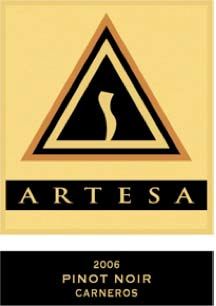 2007 Artesa Carneros Pinot Noir 13.9% alc., 22,000 cases, $25. Aged 10 months in French oak. · The is reminiscent of cherries kissed by good dark chocolate. Moderately light and smooth in texture with fine-grained tannins and admirable acidity. A very good entry Pinot Noir and daily drinker. Fantastic quality considering the extremely large case production.
2006 Block 91 D Carneros Pinot Noir 14.7% alc.,100-120 cases, price TBA. · A highly structured wine with substantial tannins. Shy on the nose but powerful in the mouth with deep, rich darker fruits complimented by smoky oak and an Oreo cookie taste. Still closed and brooding, this one will require at least 1 to 2 years in the cellar but will always be a muscular wine.
2006 Artesa Carneros Pinot Noir 13.9% alc., $25. · A light and feminine Pinot Noir showing delicate cherry and strawberry aromas and flavors enhanced with spice and savory herbs. A simple but pleasing wine with commendable balance. Perfectly fine with grilled salmon.
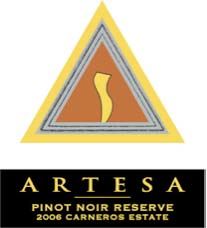 2006 Artesa Estate Reserve Carneros Pinot Noir 14.35 alc., 3,500 cases, $40. Aged in 50% new French oak. · A step up in aromatic intensity from the regular Carneros bottling. Aromas of red berries and cherries touched by herbs. Friendly in the mouth with good red fruit intensity, an appealing spiciness, and a silk and satin texture. The finish has noticeable persistence.
2006 Artesa Limited Release Carneros Pinot Noir 14.5% alc., 800 cases, $50. Aged 10 months in French oak barrels. Composed of the most outstanding barrels in the cellar. · Darkest in color of all the wines tasted. A pinotypical nose of dark berry and cherry fruit with a sidecar of oak. Tasty blackberry and black raspberry fruit with an appealing earthiness and a hint of citrus peel tang on the persistent aromatic finish. A substantial wine that is still reticent and needs time to shed some of its soft, dry tannins. A year or two in the bottle will benefit this wine. That said, I drank this wine at the winery with pan roasted wild sea bass with Meyer lemon buerre blanc, quinoa pilaf and Sicilian spinach and the result was spectacular. The roasted fish tamed the tannins of the wine and the grippy acidity of the wine matched perfectly with the buerre blanc.
2006 Artesa Haire Vineyard Carneros Pinot Noir 14.7% alc., 100-120 cases, $80. This wine is sourced from a unique site that formerly provided grapes for Etude’s Heirloom bottling. The clones are Swan and Martini. Rapidly draining compressed ash soils characterize this vineyard in contrast to the uplifted clays of varying depths over rock in the vineyards close to the winery. · Evocative scents of Bing cherry, herbs, cola, toasty oak and a faint whiff of alcohol. This wine has a silky, comforting quality that is quite sexy. The tasty cassis and cherry core has subtle notes of citrus, Provencal herbs and oak in the background. The tannins are well tamed and the overall impression is one of assertive elegance reflective of winemaking excellence.
Etude Wines: Pinot Noir is the SoulTony Soter, GangofPour.com, October 16, 2005 It was an encounter in Tony Soter’s cellar with Madam Lalou Bize-Leroy in 1980 that led to Soter’s decision to name his new wine company Etude. Lalou was assessing Tony’s first Pinot Noir and her comments were intended to imply that Tony needed to improve his winemaking approach. Etude is derived from the French word, étude, which means study and in music refers to a composition designed to improve the technique of the player. Tony remarked in Wine & Spirits (Fall 2004), “Pinot Noir is the best and most transparent wine vehicle with which to ‘study’ the craft and this has been a life long and humbling pursuit...I like to say I was in pursuit of the wisdom of ancestors I never had.”
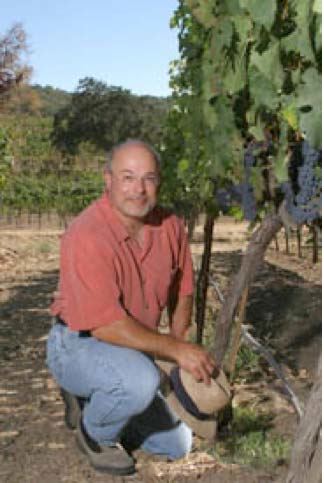 Tony Soter is one of California’s most distinguished wine pioneers. He began in the cellar at Stag’s Leap Wine Cellars in 1975 after graduating from Pomona College. This led to studies at University California Davis and his first winemaker position at Chappellet in 1977. By 1980 he had become a noted consultant and subsequently became one of the first winemaker consultants to work to express terroir from individual vineyard sites owned by Araujo Estate, Dalle Valle, Moraga, Niebaum-Coppola, Shafer, Spottswoode and Viader. He was also one of the first consultants in Napa to buy grapes by the acre in contrast to the common practice of the time of buying grapes by the ton. This arrangement pushed growers to lower yields and produced better quality fruit. Tony launched Etude Wines in 1980 with the release of a Napa Valley Cabernet Sauvignon, but quickly moved into Carneros Pinot Noir (first release in 1982), Napa Valley Pinot Blanc, Napa Valley Merlot, Carneros Pinot Gris, Brut Rosé sparkling wine and Vin Gris of Pinot Noir (one of the first and still one of the best in California). The winery was initially an underfunded side project that he indulged in while he worked his day job as a consulting winemaker to other wineries. Etude Pinot Noir was a proprietary label as Tony owned no vineyards. He developed contracts with growers which allowed him to farm his blocks to his own strict specifications. His wines quickly attracted considerable attention from the wine press and Pinot Noir aficionados. By 1999, Tony was able to end his consulting career to concentrate full time on Etude and develop his own Pinot Noir vineyard in the Willamette Valley of Oregon. Etude Pinot Noir until 2004 was sourced from selected Carneros sites. The wines are now composed exclusively of fruit from estate vineyards located in the northwestern corner of the Carneros appellation. Tony has been fanatical about quality and typically more than 20% of the wines produced each year were identified as unworthy of the Etude label and were sold off in bulk anonymously. The wines were generally aged 14 months in the finest French oak barrels, of which at least 50% were new. In exceptional cellars, Etude Pinot Noirs were known to mature harmoniously for many years. On October 25, 2005, I conducted a vertical tasting of Etude Carneros Pinot Noirs from 1992 to 2003 and the results were published in the PinotFile, Volume 5, Issue 10. Remarkably, the 1992 Etude Carneros Pinot Noir, 15 years old at the time of the tasting, proved to be one of the best wines of the night. In the pages to follow I recently tasted the 2003 to 2006 vintages of Etude Carneros Pinot Noir, completing a 15 year vertical. Vertical tastings are valuable for they allow the taster to examine a winemaker’s large body of work. With this experience comes a true appreciation of the talent and devotion that winemakers of skill offer to the wine enthusiast. Tony notes that, “The Etude Carneros Pinot Noirs draw their character from the clay-heavy soils of the appellation creating Pinot Noir that is high in extract and structure.” My drinking experiences with Etude Carneros Pinot Noirs have revealed wines of brightness, freshness and consistency of style despite vintage differences. Tannins are well integrated and polished and the wines possess an uplifting acidity that is refreshing. Of the 19 Etude Pinot Noirs rated by Stephen Tanzer in the International Wine Cellar, 17 have received a score of 90 points or more. Today, the Etude Estate vineyards are planted to nearly 20 different clones of Pinot Noir. Although most of the soils in Carneros are clay-based, the Etude Estate vineyards are planted to rocky volcanic soils that are extremely well-drained. Above ground, of course, the vines are exposed to the cool and windy weather that Carneros is known for. Spacing is dense ensuring low per vine yields. The map below shows the location of the Etude Winery and Etude’s Estate Vineyard in Carneros. The winery is in Napa Carneros and the Estate Vineyard is in Sonoma Carneros.
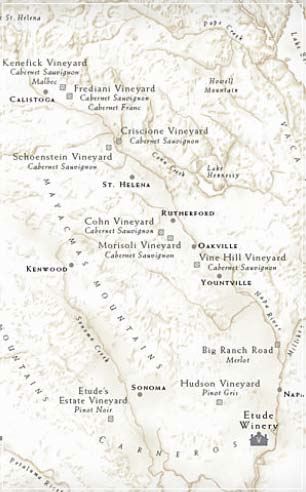 Tony made his last Etude Pinot Noir as the head winemaker in 2002 but has remained a consultant for the winery. In 2001 Etude was sold to Beringer Blass (Foster’s) which provided the capital to build a new winery, refurbish vineyards and expand production. The current winemaker is Jon Priest who came to Etude in early 2005. His winemaking background includes stints at Wild Horse Winery, Adelaida Cellars, and TAZ Vineyards. My tasting of recent vintages of Etude Pinot Noir indicate that Priest is extremely capable and the 2006 vintage Etude wines knocked my socks off.
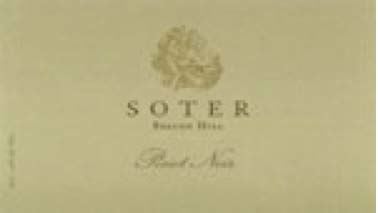 In 1997 Tony bought the Beacon Hill Vineyard, a 20-acre hillside planting on the North fork of the Chehalem Mountains, located above Willakenzie in the Yamhill- Carlton District. The site is named for a lighthouse-like structure at the top of the hill. Both Tony and his wife Michelle are Oregon natives and Tony was drawn back both by his roots and his admiration for the high quality of Oregon Pinot Noir. The Pommard and Wädenswil clones at Beacon Hill were initially planted in 1988 on their own rootstock. Additional plantings were undertaken in 1998, 1999 and 2004 including some heirloom clones Tony is famous for. An estate Beacon Hill Pinot Noir, a sparkling Brut Rosé and a Rosé of Pinot Noir were produced beginning in 1997 (Brut Rosé) and 1998 (Pinot Noir). In 2005, Tony sold the Beacon Hill Vineyard to focus on his Mineral Springs Ranch located east of the town of Carlton. Here there are a total of 32 acres of Pinot Noir planted from 2002 to 2006. Mineral Springs is the new home of Soter’s estate vineyards, winery and tasting room. A Beacon Hill Pinot Noir was produced through the 2006 vintage. One of Tony’s pet projects has been the resurrection of what he calls “heirloom clones” of Pinot Noir. A rich heritage of plant variation exists in vines, particularly with the Pinot Noir variety. The “heirloom clones” are rare “suitcase” Pinot Noir clones that he planted in small vineyard test blocks. Tony says about the suitcase clones, “Among men and women who consider themselves Grail-seekers of Pinot Noir, it is understood that smuggling is part of the tradition.” Many early California wine growing pioneers such as martin Ray, André Tchelistcheff, Dick Graff and Joe Swan hand carried select Pinot Noir cuttings from Burgundy’s top estates into the United States. Tony shares his past and present colleagues’ interest in the unique heirloom varieties of Pinot Noir and has compiled a library of rare plant material from growers’ vineyards and experimental plots. Because these clones do not produce consistently large crops and the bunches are small and irregularly shaped, they are not economically viable and are often ignored by growers. Many of the interesting clonal selections are near extinction because disease-free, consistent and reliably yielding vines are most suitable to commercial wine production. The first vintage of Heirloom Pinot Noir, 1995, consisted of only 95 cases and was the first unfiltered wine produced at Etude. The idea was to see if it was possible to bottle an unfiltered wine with extended aging from 100% new oak. There were three separate wines of two bottles each: Hudson Vineyard, Hyde Vineyard and Domaine Chandon Vineyard. The Hudson fruit came from a block planted to Dijon 115, 777 and Pommard. The Hyde block was planted to Calera selection. The Domaine Chandon bottling was sourced from their vineyard along Carneros Highway and came from a “suitcase” block planted with materials allegedly from DRC, Musigny and Romanee St. Vivant. From 1996 on, the Heirloom Pinot Noir was a blend of wines from several vineyard sources. Most of the Etude Pinot Noir in the early years was bottled after 9 months of barrel aging and was aged in about 60% new oak. The best barrels were selected and held for aging of up to 18 months for the Heirloom blend. Barrels were chosen that could hold up to 100% new Nadalie oak without becoming too oaky. The idea of Heirloom Pinot Noir was partly a case of marketing trumping reality for the wines were not always composed entirely of “heirloom” clones, but the quality of the wines were always superior. The Heirloom blend was always unfined and unfiltered. The fruit sources varied each year, but the most consistent contribution came from Adastra. In 2005, Etude dedicated a 7-acre block of estate vineyard to 10 different selections of heirloom Pinot Noir to serve as a library as well as a source for Heirloom Pinot Noir eventually insuring that all of the fruit is estate grown. The current 2006 vintage releases consists of 1,000 cases priced at $90. A small price to pay considering the unusual pedigree of the wine. Etude Heirloom Pinot Noirs are an unusual expression of Pinot Noir; darkly colored, concentrated and powerful, yet possessing a unique and highly nuanced flavor profile unlike any other Pinot Noir made in California. The wines possess lively acidity making them perfect accompaniments for the dinner table. In the following pages are my tasting notes on four recent vintages of Etude Carneros Pinot Noir (2003-2006) and nine vintages of Etude Heirloom Pinot Noir (1996-2005 - no 1999). Also included are recent vintages of the limited release Etude Deer Camp and Etude Temblor Pinot Noirs. I believe that Etude Pinot Noir is a benchmark for the Carneros appellation and the wines belong in every distinguished Pinot Noir cellar. The Etude Pinot Noirs are available on the website at www.etudewines.com. The Etude Carneros Pinot Noir is in widespread retail distribution. The best way to acquire Heirloom Pinot Noir and the limited release wines is through the mailing list. The winery is located at 1250 Cuttings Wharf Road, just off Highway 121. Tasting is available Monday through Saturday from 10:00 AM to 4:00 PM with scheduled tastings of limited release wines available Monday through Friday at 10:00 AM, 1:00 PM and 3:00 PM.
Tasting Etude Pinot Noirs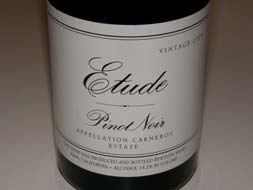 2006 Etude Carneros Estate Grown Pinot Noir 14.2% alc., $42. Aged 12-14 months in French oak barrels. Only the best barrels were chosen for the Etude bottling. · Heavenly scents of fresh black cherries and strawberries with a subtle touch of oak spice kept me returning to the glass. Delicious black cherry and black raspberry fruit core with a hint of strawberries and oak toast. Impeccable balance, silky tannins and commendable persistence on the snappy finish. A fine drink and a noticeable departure from the previous three vintages of this wine.
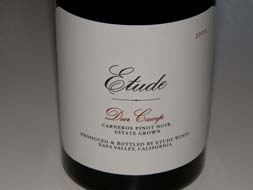 2006 Etude Deer Camp Carneros Estate Grown Pinot Noir 14.1% alc., 960 cases, $60. · This is a marvelous wine full of vim and vigor with no rough edges. Lovely aromatic profile of slightly confected black cherries and black raspberries with wood spice, herbs and a touch of good barnyard. Smooth and seamless in the mouth with gossamer tannins and sporting a juicy black cherry core followed by a taunting, teasing finish. The real deal.
 2006 Etude Temblor Carneros Estate Grown Pinot Noir 14.2% alc., 495 cases, $60. This site in the Etude Estate Vineyard is on a gradual slope that faces east and is influenced by the Petaluma Gap daily intrusion of fog. · The scents of wild berries, candy cane, allspice and truffle are long and persistent. A panoply of red fruits, particularly cherries and berries, are demure yet very satisfying. Vibrant acidity provides a juiciness and the pillowy tannins create a velvety texture. Impeccably balanced and a perfect example of why Pinot is my paramour.
2005 Etude Carneros Estate Grown Pinot Noir 14.1% alc., $42. · Dark reddish-purple in color. Extremely ripe and roasted dark fruits with notes of prune and fig on the nose. An earthy and darkly fruited wine showing mushroom and forest floor character and a clean and tangy finish redolent with grapefruit.
2005 Etude Deer Camp Carneros Estate Grown Pinot Noir 14.7% alc., $60. · Complex and intriguing aromas of spiced black cherries, wet stones, stem, raisin and oak. Dark red fruits are well composed and juicy with mild soft tannins and an appealing smooth texture. Drinks nicely but a step below the 2006 vintage.
2005 Etude Temblor Carneros Estate Grown Pinot Noir 13.5% alc.,495 cases, $60. Inaugural release of this wine, the second vineyard-designated Pinot Noir from the Etude Estate Vineyards. · Aromas of red cherries, herbs and peppermint lead to delicious flavors of cherries, herbs, oak and forest floor. Noticeable but unobtrusive fuzzy tannins and a dry finish that lingers. A good drink.
2005 Etude Heirloom Carneros Pinot Noir 14.6% alc., 1091 cases, $90. · Subdued nose of deep, dark plummy fruits and clove. The aromas just don’t seem like they have arrived yet. Juicy dark red stone fruits dominate the entry and mid palate, finishing with toothsome tannins. A little ponderous and unexciting now but the wine should become more expressive with time in the cellar.
2004 Etude Carneros Estate Grown Pinot Noir 14.2% alc., 8, 000 cases, $42. Aged 12-14 months in French oak barrels. · Rich aromas of black cherries and strawberries with a hint of oak char. Subdued dark stone fruits with some oak char and a citric tang on the finish. A little more oak shows through than the wonderful 2003 version and this wine is now more reserved.
2004 Etude Deer Camp Carneros Estate Grown Pinot Noir 14.7% alc., 470 cases, $60. The first vineyard designated Pinot Noir from the Etude Estate vineyards. This wine is named for an old deer camp structure that stands at the base of the vineyard. The parcel is so unique that it is considered a “vineyard within a vineyard.” The low vigor soil is rocky and well drained contributing to the small size of the vines. · Deep dark purple color. The fruit is overripe displaying notable aromas and flavors of raisin and port. A bold expression of Pinot Noir with deep dark fruits flanked by earth, game and feral notes. Noticeable tannic backbone and lively acidity. The cooked fruit nature of this wine was not to my taste.
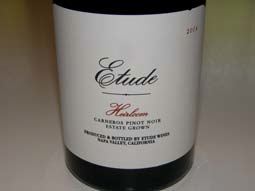 2004 Etude Heirloom Carneros Pinot Noir 14.6% alc., 40 barrels, $70. · Regal nose of black raspberry, new oak and spice. A juicy and earth-kissed cherry and berry core fans out nicely on the palate with oak char and anise in the background. A perfectly balanced wine with vibrant acidity and ripe tannins. This wine is enthralling and seems to reach every nook and cranny in the mouth. A magnificent Pinot with very powerful charisma.
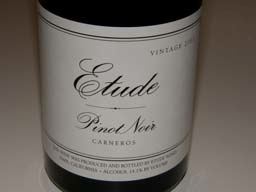 2003 Etude Carneros Pinot Noir 14.1% alc., 8,200 cases, $40. Naturally adjusted crop levels. No heat at harvest meant excellent fruit condition at harvest. This wine was part of the first crush at the new Etude Carneros winery. · Appealing aromas of black cherries, cola and oak. In the mouth the wine is pure and stylish with flavors of black cherries, strawberries and a touch of mocha with a lip smacking citrus tang to the finish. Smooth and silky and extremely well balanced. This wine is now perfectly integrated and drinking beautifully.
2003 Etude Heirloom Carneros Pinot Noir 14.2% alc., 38 barrels, $70. First bottle opened was corked. · An intense wine of admirable balance with crisp acidity. Aromas of dark cherries and berries are accented by oak and barnyard. Flavors of cherry syrup, blueberries and pomegranate are plush and satisfying. A great food wine.
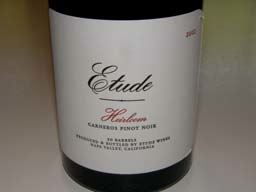 2002 Etude Heirloom Carneros Pinot Noir 14.6% alc., 30 barrels, $70. · Very lovely complex aromatic profile featuring black cherries, oak char, Asian Five Spice and dark chocolate. A pleasing core of dark cherries and berries is highlighted by oak and loamy earthy. A persistent and aromatic black raspberry finish demands another sip. Perfectly proportioned with soft tannins and ample acidity. Mercy!
2001 Etude Heirloom Carneros Pinot Noir 14.5% alc., 34 barrels, $70. · A richly sculpted wine with juicy dark red cherries and berries and an appealing earthiness. Aromas of incense and savory herbs add interest. Rich and bold with a velvety fullness that coats the mouth. A very sensual wine that aims to satisfy.
2000 Etude Heirloom Carneros Pinot Noir 14.9% alc., 20 barrels. · Very dark reddish-purple color. The fruity nose initially features black raspberries and black currant fading in the glass to reveal more oak and herbs. Dark red stone fruits and berries saturate the palate with hints of mocha and leafy vegetables. Soft tannins create a smooth drinking experience that finishes with a citrus tang. Reminiscent of an aged Gevrey- Chambertain village wine from a good vintage.
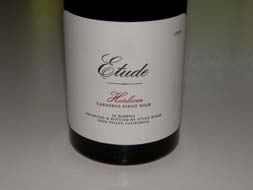 1998 Etude Heirloom Carneros Pinot Noir 13.5% alc., 16 barrels. · Attractive aromas of blackberry, earth, oak and barnyard. Plenty of powerful and brooding dark berry fruit with generous tannin still on board. Fuzzy in the mouth with decent acidity and a short, dry finish.
1997 Etude Heirloom Carneros Pinot Noir 14.5% alc., 16 barrels. · A tad better than the 1996 vintage with less Brettanomyces. Aromas of smoke and Maraschino cherry with flavors of black raspberry, prune and earth. Lively acidity and silky in texture with a clean and persistent finish. Down and dirty. Lovers of old Pinot may find solace here but the wine doesn’t deliver much interest for me.
1996 Etude Heirloom Carneros Pinot Noir 13.5% alc., 12 barrels. · This wine is burdened by Brettanomyces. Dark-fruited and plummy with a citrus note on the finish. A chunky wine whose tannins have receded but the fruit is diluted and the wine lacks any charm.
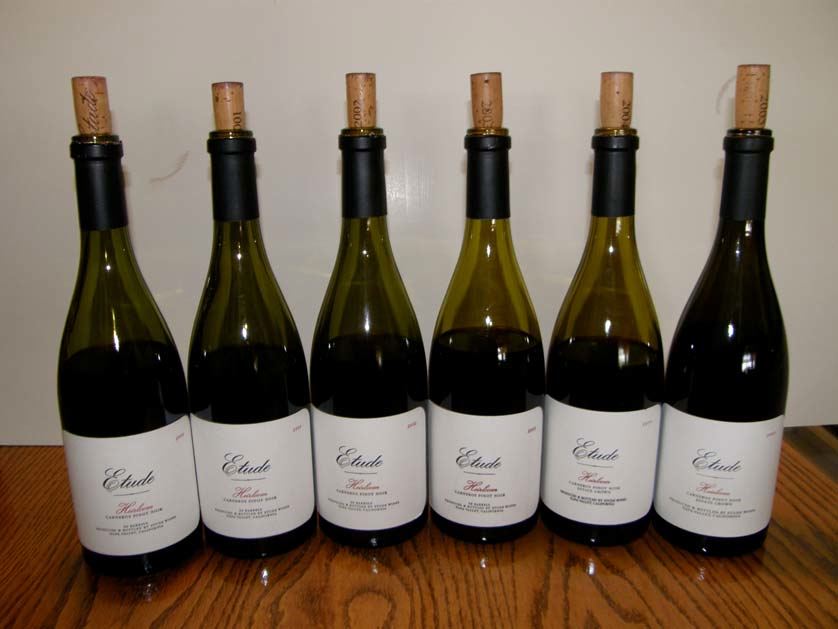
More Sips of Carneros Pinot NoirBouchaine Vineyards is the oldest continuously operated winery in Carneros. The winery’s barn-like building is surrounded by beautiful gardens and barrel hoop sculptures. The estate vineyards are among the southernmost plantings in the Napa Valley and the highest landmark terraces in the Carneros district. Long time winemaker Mike Richmond, the former founder of Acacia, has a reputation for crafting elegant and sophisticated Pinot Noirs. The winery’s Pinot Noirs are sensibly priced.
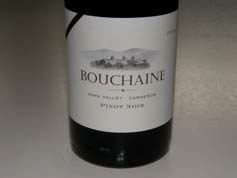 2006 Bouchaine Vineyards Carneros Estate Pinot Noir 14.5% alc., 2,500 cases, $30. · Closed initially, then opening nicely in the glass with swirling. A rich and sturdy wine with a tasty core of dark red cherries and berries with currants, tobacco and smoky oak that linger on a persistent and noticeably tannic finish. This wine will pair well now with hardy meats. Still fine the next day from an opened and re-corked bottle indicating this wine will age for 5 to 7 more years without difficulty.
The Donum Estate (Donum translates from the Latin to “gift” and refers to grapes as a gift of the land) is devoted solely to a Carneros estate Pinot Noir and a Russian River estate Pinot Noir. Winegrower and President, Anne Moller-Racke, was the Vineyard Manager for Buena Vista Carneros for many years and played an instrumental role in obtaining appellation status for Carneros and the formation of the Carneros Quality Alliance. With the sale of Buena Vista to Allied Domecq in 2001, the Racke family of Germany split off 250 acres of the Buena Vista Estate to form The Donum Estate as well as to grow grapes for the rejuvenated Robert Stemmler label. The true origins of the Pinot Noir selection in the Donum Estate Vineyard are unknown and the selection has become known as the Donum “clone.” The Donum Vineyard also contains several other clonal selections including Calera, Hanzell, Swan and Dijon 777. The winemaker for The Donum Estate and Robert Stemmler is talented, young Kenneth Juhasz, who also crafts wine under his own label, Auteur. The first release of The Donum Estate Carneros Pinot Noir was 2001.
2003 Donum Estate Carneros Estate Grown Pinot Noir 14.5% alc., 575 cases, $60. Cool weather at bloom caused a light set and yields were only 1.88 tons per acre. 100% de-stemmed, cold soaked for 4 days, aged on the lees in 75% new French oak for 11 months. · Expressive nose starring black cherries and hinting of Provencal herbs and smoke. A full flavored black fruited wine with a soft texture and gentle finish. Smoky oak accents carry thru and persist on the aftertaste.
 2006 Donum Estate Carneros Estate Grown Pinot Noir 14.4% alc., 850 cases, $65. Unusually long growing season. The vineyard averages 115 days from bloom to harvest but in 2005 it was 130 days. 100% de-stemmed. Cold soaked 5 days. Aged on the lees 11 months in 75% new French oak. · Deeply colored. Vibrant and deep aromas of black raspberries, blackberries, toast and herbs. Darkly fruited and fullbodied in style with soft tannins and a strikingly velvety texture. The flavors are complimented by an earthiness and subtle oak char. Clearly one of the top wines from the Carneros region in this vintage.
Schug Carneros Estate Winery was founded in 1980 by Walter Schug who was the founding winemaker at Joseph Phelps Vineyards in the 1970s. In 1995, Sonoma born winemaker Michael Cox joined the winery and he has carried on the Schug tradition while instituting modern winemaking techniques.
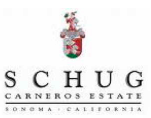 2006 Schug Carneros Pinot Noir 13.5% alc., $28. · A simple but satisfying Pinot Noir featuring cherry and berry fruit, a sprinkling of herbs, a hint of smoke and a touch of citrus. Moderately light in body with silky tannins and a clean finish. A perfectly fine daily drinker.
Saintsbury cofounders David Graves and Richard Ward celebrated their winery’s 25th anniversary in 2006. Together they launched Saintsbury in 1981 after meeting at University California Davis and discovering they had a shared passion for Pinot Noir. They decided to stake their claim in Carneros and sourced all of their grapes from that appellation. They released 2000 cases of Pinot Noir from purchased grapes in 1981 and never looked back. By 1991, production had increased to 35,000 cases and their Pinot Noir was on practically every restaurant list in the United States. Graves and Ward like to kid about their success, thankful because, “Our attitudes and work habits make us otherwise unemployable.” The hallmark of Saintsbury wines has been a high quality to value ratio and consistency from vintage to vintage. Saintsbury has about 13 acres of vineyard around their unpretentious and weathered barn-like winery and the estate-owned Brown Ranch Vineyard nearby, but they source most of their grapes from Napa Carneros growers through long-standing relationships. Winemaker Byron Kosuge left Saintsbury in 2004 to pursue his own label and was replaced by Jerome Chery who apprenticed with Littorai’s Ted Lemon from 2000 to 2004. In 2004, Saintsbury abandoned their Reserve bottling and launched a series of vineyard-designated Pinot Noirs from Napa Carneros. Saintsbury also produces a Carneros appellation bottling that is widely available, Garnet which is a lighter-styled early drinking Pinot Noir and a Vin Gris of Pinot Noir (Vincent Vin Gris). The Saintsbury Brown Ranch Carneros Pinot Noir is the winery’s flagship, the only vineyard-designated Pinot Noir produced from estate fruit and consistently an outstanding collectable wine.
 2006 Saintsbury Brown Ranch Carneros Pinot Noir 14.5% alc., $60. · Enticing aromas of strawberries, Bing cherries, brown sugar and baking spices. An elegant and softly textured Pinot Noir featuring a red fruit profile, a touch of earthiness and a deft touch of oak in the background. A seamless wine with a lingering fruit-kissed finish. Not as stellar as the 2005 vintage, but a fine wine in its own right.
Saintsbury Winery is named after George Saintsbury, who in the early 19th century wrote Notes on a Cellar-Book. Historian Thomas Pinney has updated Saintsbury's work in a new edition published by UC Press, Berkeley ($29.95). Much of Saintsbury's writing was confounding and obscure to say the least, but Pinney has brought many of Saintsbury's references and his obtuse commentary to light. The book is a great read for lovers of historical writings on wine.
Talley Vineyards: Classic & DependableThe Talley family has been farming in the Arroyo Grande Valley since 1948 when Oliver Talley established Talley Farms. Originally vegetable farmers, Oliver’s son, Don, began planting grapes in the 1970s on the farm’s steep hillsides that had been devoted to avocado trees. The first Talley Vineyards Pinot Noir was produced in 1986 from early Rincon Vineyard plantings after winemaker Steve Rasmussen was lured away from Corbett Canyon. In 1991, a modern 8,500 square foot winery was completed at the foot of the Rincon Vineyard. Brian Talley, the third generation of Talleys to graduate from University California Berkeley, assumed control of winery operations when the winery opened. Initially he worked with Rasmussen in developing the Talley style, but would eventually concentrate on the viticulture side of the family business. A barrel storage facility and tasting room was added to the property by 2002. After 20 years at the winery, an unusually long tenure among today’s often itinerant winemakers, Rasmussen was replaced by Leslie Mead who came from Bonny Doon. Talley Vineyards now farms 190 acres of vineyards in the Edna and Arroyo Grande Valleys. There are three vineyards producing Pinot Noir: Rincon (95 total acres, 38 acres of Pinot Noir), Rosemary’s (28 total acres, 17 acres of Pinot Noir) and Stone Corral (27 acres all Pinot Noir). Rincon Vineyard was originally planted in 1982 but modern additions date most recently to 2001. Rincon is planted to clones 2A and Dijon 115, 667 and 777. Older vines are on their own roots, while more recent plantings are on resistant rootstock. Soils are shallow loam and calcareous clay similar to that found in the Cote de Nuits. Rosemary’s Vineyard is located 1 mile west of Rincon Vineyard in a somewhat cooler site closer to the Pacific Ocean. Planting was started in 1987 with additions through the 1990s and the clones are the same as Rincon with multiple rootstock selections. Soils are rocky sandstone and loam with some clay in the subsoil. Stone Corral is a new vineyard in the Edna Valley planted in 2001 to Dijon 115, 667 and 777 and 2A field selection from Rosemary’s Vineyard. The first Talley Vineyard Stone Corral Pinot Noir was released in 2004. Soils are diverse in type ranging from sandy clay loam to finely textured sand. Grapes from the Stone Corral Vineyard are split among Talley Vineyards, Kynsi Winery and Stephen Ross Wine Cellars. Brian Talley and Kevin Wilkinson manage the Stone Corral vineyard. Maps of all the Talley family vineyards are available on the website at www.talleyvineyards.com. Long-term sustainability is the principle in farming these vineyards. Pesticides are avoided, cover crops and compost are used to improve the soil’s condition, drip irrigation is used sparingly, and leaf pulling and lateral shoot removal are employed throughout the vineyards to expose the grapes to more air and sunlight. Pinot Noir winemaking at Talley Vineyards is traditional with some whole cluster inclusion depending on stem lignification. All fermentations are native and aging is carried out in medium-toasted 30-40% new French oak barrels for 15 to 18 months before bottling. The Pinot Noirs are rich, concentrated and full-bodied but never overwrought and beautifully crafted.
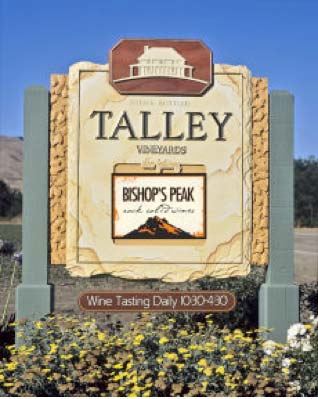 Currently the vineyard produces about 18,000 cases annually. All wines released under the Talley Vineyards label are grown, produced and bottled by the Talley Family. Estate vineyard-designated Pinot Noir and Chardonnay are the flagship of Talley Vineyards but the broader estate and appellation releases and a second, value priced label, Bishop Peak, are also commendable wines. There is also a 2005 Mano Tinta Pinot Noir from East Rincon Vineyard currently available in magnums with the sales benefiting The Fund for Vineyard and Farm Workers. The vineyard-designated Pinot Noirs age extremely well and are usually best consumed several years after their release. The Talley Vineyard Rincon and Rosemary Pinot Noirs are highly sought after and are sold primarily through a mailing list. The 2006 wines reviewed below are currently available on the winery’s website. The Chardonnays have many fans as well. The Talley Vineyards tasting room, open daily, is located just ten minutes from Highway 101 in Arroyo Grande. The picnic areas offer a welcome respite. Directions are available on the website at www.talleyvineyards.com. 805-489-0446. A few years ago I asked noted California winemaker, Ted Lemon, to name other California producers of Pinot Noir that he admired. He mentioned two, Rochioli and Talley Vineyards. Enough said.
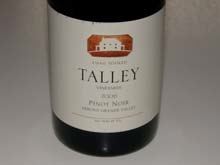 2006 Talley Vineyards Estate Arroyo Grande Valley Pinot Noir 14.3% alc., $36. 82% Rincon Vineyard fruit and 18% Rosemary’s Vineyard fruit. Yields were 1.4 tons per acre. Aged 15 months in 30% new French oak barrels. · Deep red fruits with a touch of stem and herbs. Moderately light in body, pure and bright in nature, soft and silky in texture, with pleasing balance. Fine, but no better than many entry level California Pinot Noirs priced less.
2006 Talley Vineyards Stone Corral Vineyard Edna Valley Pinot Noir 14.5% alc., 190 cases, $50. Yields 2.6 tons per acre. Aged 16 months on the lees in 35% new French oak barrels. · This wine opens beautifully in the glass revealing scents of demure dark fruits, spice, oak and pine. Well-composed dark stone fruits and pomegranate with an earthy underpinning and notes of anise and chocolate. Ample acidity contributes to a lively finish. This wine will reward cellaring as it just doesn’t grab your attention yet.
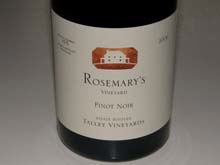 2006 Talley Vineyards Rincon Vineyard Arroyo Grande Valley Pinot Noir 14.5% alc., 550 cases, $70. 2.1 tons per acre. Fermented with native yeast in open top fermenters. Aged on the lees 18 months in 35% new French oak barrels. · Dark reddish-purple color. Great nose composed of black cherries, herbs and toast. Darkly fruited, earthy and primal. Dense but not jammy. Tannins are well-tamed and the finish shows lively acidity. Reserved and not as forthcoming now as the 2006 Rosemary’s but equally well crafted and very age worthy.
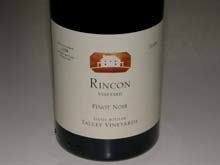 2006 Talley Vineyards Rosemary’s Vineyard Arroyo Grande Valley Pinot Noir 14.5% alc., 556 cases, $70. Yield 2.2 tons per acre. Fermented with native yeast in one ton open top fermenters. Aged on the lees 18 months in 35% new French oak barrels. · Deep dark reddish-purple in color. Charming aromas of black cherries, black raspberries and black currents with touches of spice and soy and floral overtones. Richly flavored dark stone fruits with a sidecar of oak. Very silky and elegant on the palate with a refreshing liveliness on the finish. A very satisfying wine with plenty of punch but not in the least over extracted. This beauty will age very well.
2002 Talley Vineyards Rincon Vineyard Arroyo Grande Valley Pinot Noir 14.5% alc., 380 cases, $65. · Slight orange patina on the rim. Very “Burgundian” with a bouquet of forest floor, loamy earth, herbs and new leather. Well-herbed and earth-kissed dark fruits envelope the tongue and nicely seasoned oak compliments the fruit. The tannins are pillowy. Still very fresh and perfectly balanced to go several more years. The most “Burgundian” wine from California I tasted in 2008.
Alma Rosa: The Newest from Richard SanfordRichard Sanford is a revered icon in the annals of California Pinot Noir, having been largely responsible for putting the Santa Rita Hills on the wine map. He planted the famous Sanford & Benedict Vineyard in 1970 with partner Michael Benedict. At the time, Richard was a student of geography and he had a hunch that led him to plant 110 acres to Pinot Noir and Chardonnay 9 miles west of Buellton at the western end of the Santa Ynez Valley on Santa Rosa Road. Victor Geraci notes in his book, Salud! The Rise of Santa Barbara’s Wine Industry, “He traveled through the Burgundian region of France and began to dream of a life in agriculture. He had no agricultural experience and thus went through the agonizing decision of whether to go to UC Davis for a master’s degree in enology or to plant a vineyard and learn through trial and error....Being a little crazy, Sanford decided in that year (1970) to go directly into business.” In 1980, he ended his partnership with Michael Benedict and lost the vineyard. Benedict subsequently sold his share to a British businessperson, Robert Atkin. Atkin then invested in Sanford’s winery which was founded in 1981 and hired Sanford to manage the Sanford & Benedict Vineyard. Sanford was a strong advocate of organic farming from the beginning. Winemaker Bruno d’Alphonso joined Sanford Winery in 1983 and Sanford wines became quite popular. By 1993, the winery was producing 30,000 cases a year. In 1997, Sanford planted a second vineyard, the 130-acre Rancho La Rinconada adjacent Sanford & Benedict Vineyard and in 2001 he completed his dream winery on the property. Although the winery is an architectural marvel and a landmark for the region, Sanford’s original modest tasting room has gained more notoriety for its cameo in the book and movie, ‘Sideways.’ In the book, Jack buys a bottle of 1999 Sanford La Rinconada Pinot Noir and exclaims, “Lovely, big and gamy, almost irreverent for a Pinot. I like it. A perfect beginning to this week long adventure.”
 Beginning in 2002, a number of events played out that eventually led Sanford loosing his namesake winery. The details are unclear but Terlato Wine Group, owners of Paterno Distributing, were brought in as an investor in the Sanford Winery due to slow sales. Disagreements regarding vineyard management and winery production followed and by 2005, Richard and Thekla Sanford had left to begin a new venture, Alma Rosa Winery and Vineyards. Alma means “soul” in Spanish reflecting the Sanford’s view that their wines reflect the soul of the Rancho Santa Rosa, the original Mexican land grant on which their vineyards are planted. The first Alma Rosa wines were released in 2004. D’Alphonso left Sanford as well, started his own label, Badge, and became the first winemaker for Richard Sanford at Alma Rosa. The current winemaker is Christian Roguenant who also crafts wine at Orcutt Cellars and Baileyana. Alma Rosa produces wines from the Sanfords’ 7-acre El Jabali Vineyard (planted in 1983 and consisting of 3.5 acres each of Pinot Noir and Chardonnay) and the 100-acre vineyard they lease west of La Rinconada called La Encantada (planted in 2000 and consisting of 96 acres of Pinot Noir). Both vineyards are certified organic (the first to be so certified in Santa Barbara County).
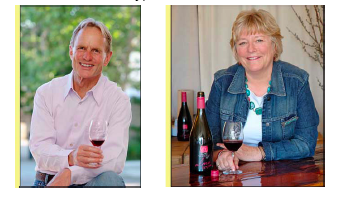 What I most remember and admire about Richard Sanford is that he tirelessly poured his wines at many events over the years, patiently answering all questions with polite aplomb and enthusiasm. When I first became seriously interested in wine in the 1980s, Richard was participating in even small wine charity events and it was through encounters with him at these tastings that I became impressed by the man and his stellar wines. Even today, he and his wife eagerly participate in major Pinot Noir events, not at all content to rest on their laurels. All the Alma Rosa Pinot Noirs are darkly colored, highly structured, fruit-driven and noticeably tannic. At this stage they are not evolved and the aromas are reticent although the pedigree of the well-endowed fruit shows through. They will be more enjoyable in 1 to 3 years when the tannins meld but they will always be big, bold, darkly fruited and powerful Pinot Noirs. If you drink now, decant.
2007 Alma Rosa Sta. Rita Hills Pinot Noir 14.5% alc., $38, 6,301 cases, screw cap. · Rich and thick aromas of dark fruits and smoke. Deep, dark and intense black raspberry flavor with noticeable but fine-grained tannins and good acidity. Needs substantial food.
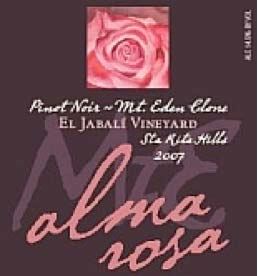 2007 Alma Rosa El Jabali Vineyard Mt. Eden Clone, Sta. Rita Hills Pinot Noir 14.5% alc., 236 cases, $49, screw cap. · Perfumed and floral with spiced raisins dominating. Light in the mouth with rich and juicy raspberry fruit finishing with a flourish of tannin. The most pinotosity and elegance of the three single clone bottlings. Tasted the next day from an opened and re-corked bottle, the wine was more approachable indicating patience is required. Hands off for 2-3 years.
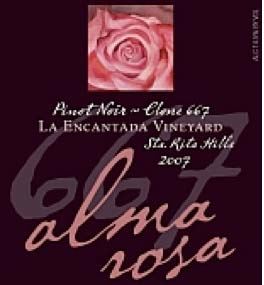 2007 Alma Rosa La Encantada Vineyard Clone 667 Sta. Rita Hills Pinot Noir 14.5% alc., 234 cases, $49, screw cap. · This wine has an interesting aromatic profile showing cherries, earth, oak and masa. A bit of heat peaks out. Composed of both red and blue fruits with oak playing a backup role. Medium-bodied a silky mouth feel and noticeable tannin.
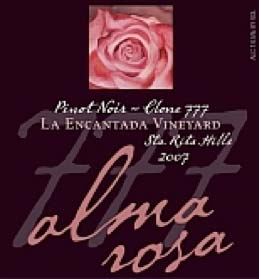 2007 Alma Rosa La Encantada Vineyard Clone 777 Sta. Rita Hills Pinot Noir 14.5% alc., 235 cases, $49, screw cap. · Pleasant aromas of smoke-tinged black cherry. Dark berries and cherries form a healthy and flashy core of fruit. Smooth, silky and clean with moderate ripe tannins.
2007 Alma Rosa La Encantada Vineyard Sta. Rita Hills Pinot Noir 14.5% alc., $49, screw cap. · Shy but pleasant black fruits and polished smoky wood on the nose. Sweet and plentiful black raspberry fruit with an oak accent. The wine sports plenty of dry tannins and a clean and lingering finish.
2006 Alma Rosa El Jabali Vineyard Sta. Rita Hills Pinot Noir Vin Gris 13.8% alc., $20, screw cap. · The wine has a pretty orange-coral color that matches the color of the capsule. On the nose, tropical fruits, pineapple and butter give way in the glass to strawberries, persimmons, orange peel, marzipan and a hint of oak. Flavors echo the aromas with admirable richness and viscosity. Very food friendly due to the lively acidity which provides a bright and refreshing finish.
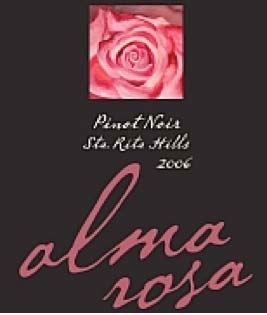 2004 Alma Rosa Sta. Rita Hills Pinot Noir 14.0% alc. $40, screw cap. · This wine is holding its own nicely. I prefer it over the 2007 version. Lovely red cherry popsicle flavors that are crisp and clean with a hint of smoke, wood and grass. Very mild tannins still linger, bright acidity lifts the finish and the wine drinks beautifully.
Alma Rosa Winery and Vineyards tasting room 7250 Santa Rosa Road is open daily. The single clone wines are only available here. Visit the website at www.almarosawinery.com. 850-688.9090.
Mountford Estate: Waipara Gem
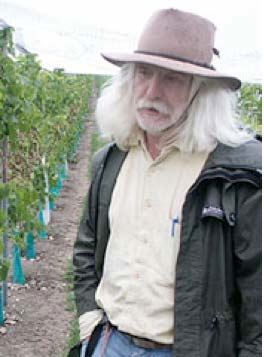 Writing about wine can be boring but writing about the people behind wine can be fascinating. Case in point is Mountford Vineyard in the Waipara region of New Zealand’s South Island. Mountford’s winemaker is Taiwan-born C.P. Lin who is blind. The story goes that when Lin was at lunch where the owners of Mountford, Michael and Buffy Eaton, were dining, he correctly identified the type of cigar Michael was smoking by the smell. Lin quickly won the job that day in 1997. Lin was blinded by retinoblastoma (carcinoma of the retina) at age three but was driven to succeed as he grew older. He graduated from the University of Canterbury with a degree in mathematics. While attending college, he developed a love for wine through the university’s wine club. This led him to attend Lincoln University’s viticulture course but could not graduate because his disability prevented him from completing the practical laboratory work required for a degree. Lin went on to work in the wine industry, relying on his sense of smell and taste. He was able to work in the vineyards as well, using touch to prune the vines. The vineyards at Mountford Estate are planted on steep hillsides to Pinot Noir and Chardonnay. Planting started in 1991, the first wines were released in 1995, and a winery was completed in 1998. Yields are painfully low at 1 to 1.75 tons per acre. Viticulturist Gerald Atkinson manages the 15-acre vineyard which contains 11 different rootstocks and 17 different clones of Pinot Noir and Chardonnay. Many individual small blocks are vinified separately before assemblage into the winery’s estate wines. Eventually, block-designated Pinot Noirs will be produced from the vineyard. The wines of Mountford Estate have become a cult wine in New Zealand. Only about 2,000 cases are produced annually and most of it ends up in restaurants or is exported.
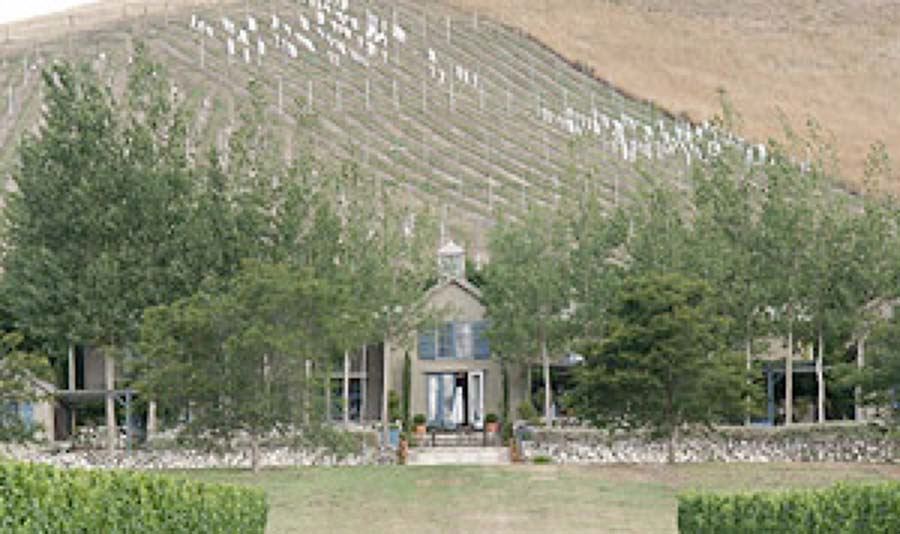
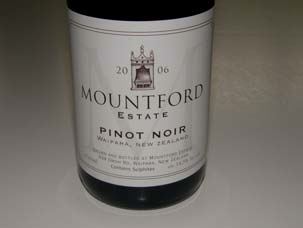 2006 Mountford Estate Waipara New Zealand Pinot Noir 14.5% alc., $65. Estate grown and bottled.Imported by Leucadia Cellars & Estates LLC, San Francisco, CA. · Very fruity nose featuring redder fruits and a touch of oaky funkiness. Beautiful core of succulent dark red Pinot fruits carefully oaked. Very silky, even sensual, in the mouth with ample acidity and gossamer dry tannins. A nicely composed wine with character and charisma.
The winery website is www.mountfordvineyard.co.nz. The wine is sold under the name The Mount in Australia to avoid confusion with a West Australian producer named Mountford Vineyard. In the United States, the wine is available at www.winex.com and other retail sources.
Pinot BriefsAmericans in Burgundy Scott Wright, the owner of Scott Paul Wines, is producing a wine from Burgundy. A single barrel of 2008 Chambolle-Musigny Les Bussiéres will be bottled in December 2009 for release in early 2010. As a Chambolle freak, Scott is understandably excited about the first Scott Paul Chambolle. Scott Paul Wines is located in Carlton, Oregon and is the only winery I know of offering Burgundy wines both for sampling and for sale in the tasting room. Listen to an interview of Scott Wright in 2008 on Grape Radio (www.graperadio.com). Ray Walker is a 27-year-old Burgundy lover who left his successful career in finance a few years ago to pursue his dream. After learning winemaking under Ed Kurtzman of Freeman Cellars and August West, he immersed himself in the French language and culture to prepare for a career as a negocient in Burgundy. He left February 8 for Burgundy to lay the groundwork for his new Burgundy label, Domaine Ilan. Listen to an interview with Ray on Grape Radio. Walker’s website is www.domaine-ilan.com. Sebastopol Hills Noted Pinot Noir authority and author of two reference books on Pinot Noir, John Winthrop Haeger, has recently described a well-defined subregion of the Russian River Valley. Called Sebastopol Hills, the area is marked by rolling hills and is located southwest of Sebastopol between the Petaluma Gap and the Russian River Valley proper. Many winemakers who source grapes from this region feel that the Pinot Noirs grown here are distinct from those originating in the nearby Green Valley, Petaluma Gap and true Sonoma Coast regions. The Pinot Noirs are said to have darker fruit and more minerality, with more of a masculine bent. Haeger reports that in tastings, Sebastopol Hills Pinot Noirs demonstrate “A preponderance of earthy and savory elements with unusual notes of salt marsh, iodine and pepper, and undertones of sober, dried fruit - a marked contrast to the exuberant fresh fruitiness that often typifies Russian River, and the wild, exotic, garrigue-like flavors that often mark wines from the true Sonoma Coast.” Examples are Halleck Hillside Cuvee Sonoma Coast Pinot Noir, Balletto Burnside Vineyard Russian River Valley Pinot Noir, Inman Family Thorn Road Ranch Russian River Valley Pinot Noir and Vergari DuNah Vineyard Russian River Valley Pinot Noir. Read the full story at www.sfgate.com (published August 29, 2008). Common rootstocks There are around 20 rootstocks available for commercial use in vineyards. 1103 Paulsen and 101-14 account for 80 percent of plantings. They both are resistant to phylloxera and nematodes with 101-14 being the most immune to nematodes. 101-14 is low to moderate in vigor and 1103 is moderate to high in vigor, depending on the soil.
 Vineyard Walks Zephyr Wine Adventures offers guided walks in several wine regions that are combined with private wine tours and tastings, walks through vineyards and meals. You don’t have to be a strong athlete to participate. The next Sonoma Vineyard Walking tour is October 25-29, 2009 ($1900 including lodging, tasting fees and meals). An Oregon Multisport Wine Adventure is offered August 23-27, 2009 ($1800), which combines walking, canoeing and bicycling with visits to wine regions ranging from Eugene to the northern Willamette Valley to the Hood River appellation. A Burgundy Walking tour will be offered in 2010. For further details, visit the website at www.zephyradventures.com. Fetzers Return Ben and Jake Fetzer plan to make Pinot Noir from a 40 acre vineyard in Mendocino County, part of 1,500 acres acquired after the sale of the Fetzer Winery in 1992. The wine will be crafted by Greg LaFollette and will be dedicated to Ben and Jake’s father, Bobby Fetzer who died in 2006.
 Gary Andrus Passes Away Gary Andrus was a much admired winemaker who leaves behind a legacy of three notable wineries, Pine Ridge in California, Archery Summit in Oregon, and Gypsy Dancer which produced wine from both New Zealand and Oregon. Last year, Andrus became ill and was unable to finish his Oregon wines from the 2007 vintage. In stepped winemaker John Grochau, who bought some tanks of Pinot Noir that would have ended up in Gypsy Dancer wines. Grochau Cellars 2007 Commuter Cuvee Pinot Noir is sourced primarily from the Chehalem Mountains and priced at only $12, this wine is a true recession buster. Profits from the sale of this wine are being donated to the Brett Jarolimek Memorial Fund (Brett was a noted cycling advocate in Portland when he was struck by a truck in October 2007 and died). The wine is available from Story Teller Wine Company (www.storytellerwine.com). Grand Cru Estates Opening A 17,000 square foot gravity-flow winemaking facility will open in the summer of 2009 in the northern Willamette Valley. The private “members only” club will offer wine enthusiasts a handson opportunity to make their own premium Oregon Pinot Noir with the personal assistance of the winemaking team of Laurent Montalieu (Soléna) and Tony Rynders (formerly Domaine Serene) who have been in the winemaking industry for three decades. Participants can be present at every step of the way from harvest to bottling or simply come and enjoy the winery, conference center and gardens for their own use. The facility includes high-tech conference rooms, a professional kitchen (consulting chef is Phillipe Boulot of the Heathman Restaurant and Bar), solar power, and organic kitchen garden. There are a variety of membership levels available. For more information or to request a membership prospectus, visit www.thegrandncruestates.com.
 J Vineyards & Winery Launches New Food and Wine Tasting Program J’s Bubble Room is a private tasting salon with seating and table service complete with resident Executive Chef Mark E. Caldwell’s new three-course menu which replaces the previous menu of three smaller flights. A total of seven wines are offered including Chardonnay, Pinot Gris, Pinot Noirs, Brut Rosé, Late-Disgorged Vintage Brut and Ratafia dessert wine. The new tasting costs only $60 per person and is available Friday through Sunday from 11:00 AM to 4:00 PM. J has also introduced a premium-level, wine-only tasting at its Signature Bar featuring J’s outstanding high-end small-lot single-vineyard Pinot Noirs and Late Disgorged Vintage Brut sparkling wine. For the ultimate food and wine tasting experience, the Essence program is offered on Thursdays. By appointment only, the program offers a private tour of the winery and vineyards along with a seven-course fine dining meal in the Bubble Room ($200 per person and limited to 8 guests). J Vineyards and Winery is located at 11447 Old Redwood Highway in Healdsburg. 1-800-JWINECO. Flavors of Carlton Good fun and wine on Saturday, March 7 from 5:00 to 9:00 PM at Scott Wright Cellars in Carlton. This event offers an opportunity to taste wines from Andrew Rich, Soter, Soléna, Belle Pente, Elk Cove, Raptor Ridge and others. A collection of Eyrie Vineyards Pinot Noirs crafted by recently deceased David Lett has been donated by Lett’s family, other winemakers and private collectors and will be auctioned. The event will benefit the nonprofit Carlton Together Cares which offers free and low-cost programs for children, teens and their families. $50 per person. For reservations, call 503-852-4405 or write info@carltontogethercares.com. Wine Judge Reliability Questioned Robert T. Hodgson reported a research study, “An Examination of Judge Reliability at a Major U.S. Wine Competition,” in the Journal of Wine Economics, Volume 3, Issue 2, Fall 2008. Wine judge performance at the California State Fair Wine Competition was analyzed from 2005 to 2008 using replicate samples. Each panel of four expert judges received a flight of 30 wines imbedded with triplicate samples poured from the same bottle. Between 65 and 70 judges were tested each year. About 10 percent of the judges were able to replicate their score within a single medal group. Another 10 percent, on occasion, scored the same wine Bronze to Gold. Judges tend to be more consistent in what they don’t like than what they do. An analysis of variance covering every panel over the study period indicated less than 50 percent of the panels presented awards solely on wine quality. Read the whole article at www.wine-economics.org.
 New Winemaker at Keller Estate Ross Cobb has been working at several notable wineries throughout the Sonoma Coast (Coastlands Vineyard, Flowers Vineyard & Winery) after graduating from the University California Santa Cruz with a degree in environmental science and sustainable agriculture. Read more at www.rosskcobb.com. He is the new winemaker at Keller Estate and will be pouring at the upcoming World of Pinot Noir in Shell Beach, March 6 and 7, 2009.
 Kosta Browne Using Kodak Anti-counterfeiting Labelling The problem with wine counterfeiting has become more common, especially with wines sold at auction. The Kodak Traceless System is an ultra covert technology using forensically invisible markers that can be added to printing inks, paper or other packaging elements during the manufacturing process. The markers are only detectable by Kodak Traceless pen readers, made available to wineries like Kosta Browne. Other wineries that are incorporating Kodak’s technology include Colgin Cellars, Vineyard 29 and Staglin Family Vineyards. Pinot Noir Acreage According to Wines & Vines (October 2008), there were 8,179 acres of Pinot Noir planted in California in 1998 and 24,427 acres in 2007. No other grape variety can match this increase of 300% (Cabernet Sauvignon plantings increased 250% to 74,643 acres during this time interval).
Pinot Buys in Tough TimesThese days I am experimenting with optimism and I encourage you to do the same. It is unfortunate and even ironic that Pinot Noir from one of the greatest vintages EVER in California - 2007 - are arriving at a time when many pinotphiles are scaling back wine purchases. 2007 was blessed with perfect weather throughout the growing season all over California. During my travels in the last six months along the Pinot trail in California, I was struck by the consistent high quality of the Pinot Noirs from this vintage. Wines in barrel are very precocious and promiscuous, offering unusually good drinkability early on. In addition, there is plenty of Pinot Noir to go around, unlike the next vintage - 2008 - where frost, rain, hail and heat during the growing season severely restricted yields. The 2007 Pinot Noirs from Oregon are perfectly fine as well, more classic in style than the densely fruited and higher alcohol wines of 2006. Small producers of Pinot Noir will be hard hit by reduced consumer spending. Many wineries are offering incentives including free shipping and 10-20% reductions in price for buyers of 6 to 12 bottles. This is an opportunity to scoop up incredibly good Pinot Noir at reduced prices. Examples: Benovia Winery - free shipping on purchases of 6 bottles; Kistler - free shipping on purchases of 12 bottles or more; Dutton-Goldfield - 15% off case purchases; Paul Mathews - 20% off for club members; Loring - 20% off case purchases ($40 a bottle includes shipping); McPhail - free shipping in February; Red Car - 10% off to mailing list members Halleck - 2006 Three Sons Cuvee, 4 bottles for the price of 3, 8 bottles for the price of 6 and a full case for the price of 9 including free shipping. Inquire about discounts offered by your favorite wineries. I would encourage you to patronize your favorite Pinot Noir producers, even if you are not able to buy your usual allocation. Every little bit helps. Some have called me a Pinot pimp and I have never denied the charges. That said, a couple of years from now when we emerge from this financial fiasco, you will be happy that you scored some choice bottles of Pinot Noir from the 2007 vintage.
Quite an Oregon Fish StoryThis sturgeon was caught on the Willamette River just below Oregon City a few weeks ago. It weighed over 1,000 pounds and measured 11’1” in length. It took over 6 and half hours and 4 dozen beers (low estimate) for the 4 guys taking turns to reel it in. The sturgeon is still alive in the photo and was released unharmed. How did the sturgeon get so big? The rumor is the fish had a steady diet of Oregon Pinot.
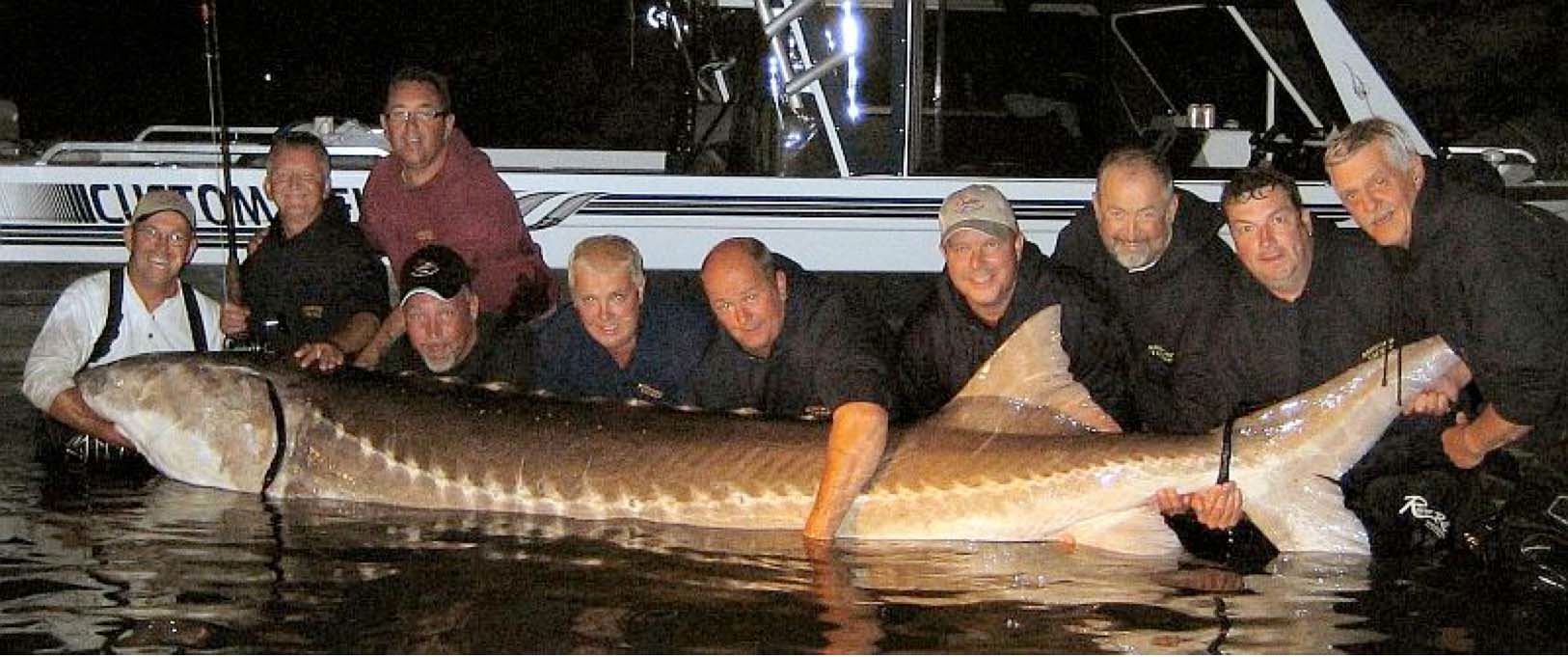 |